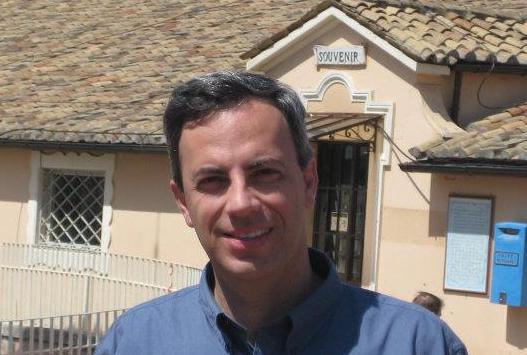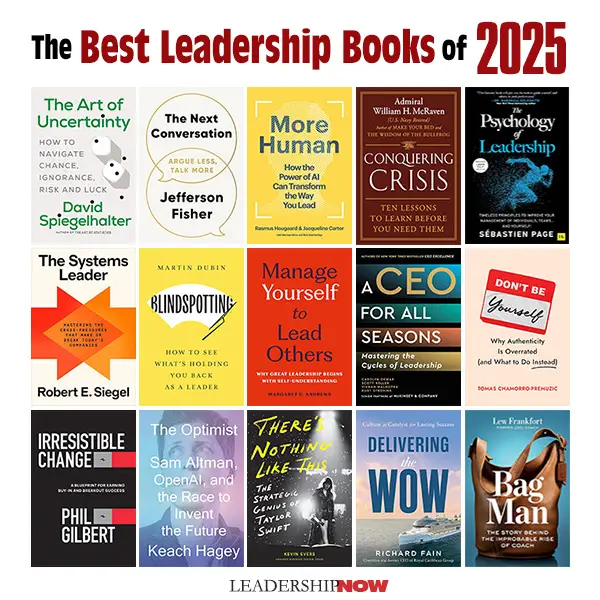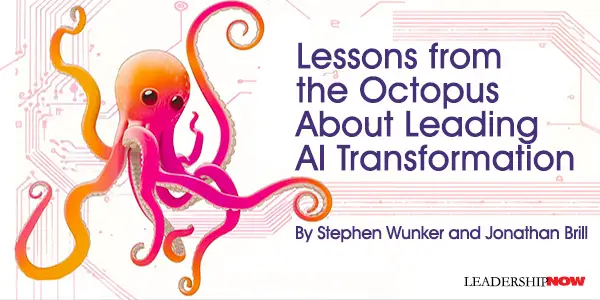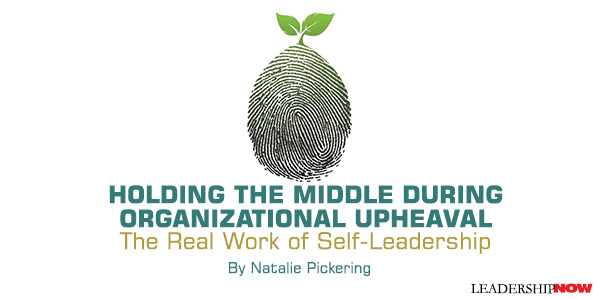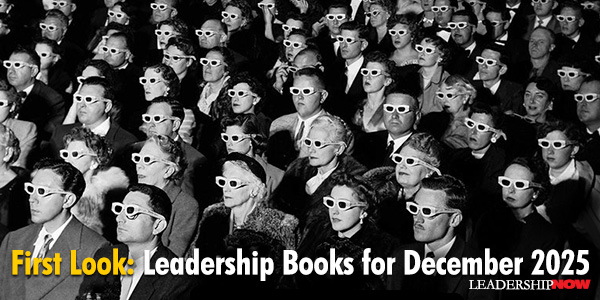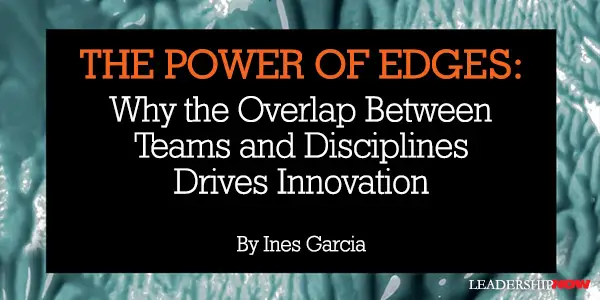These are regularly updated feeds from several websites and blogs about leadership
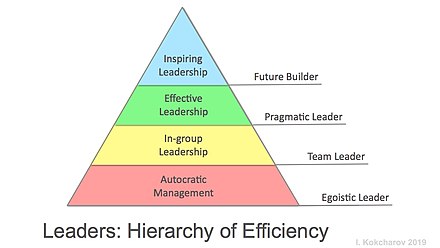
- Complain Moreby Dan Rockwell on December 26, 2025 at 11:31 am
Stores are filled with people returning gifts on December 26. Complaining done well increases happiness. Don’t get the wrong impression. Curmudgeons are toxic. Big shots are never happy. They complain because the world doesn’t revolve around them. Enjoy the value of complaining.
- Leading Thoughts for December 25, 2025by Michael McKinney on December 25, 2025 at 9:28 pm
IDEAS shared have the power to expand perspectives, change thinking, and move lives. Here are two ideas for the curious mind to engage with: I. Nicole Vignola on learning: “The first major underpinning of a growth mindset is that people with this mindset understand that learning is a valuable opportunity in the face of adversity. When people believe that they can improve and grow from failure and setbacks, they are more likely to engage in challenging tasks and persist through difficulty. When people know and understand that the brain is malleable and are willing to adapt to circumstance, they are likely to persist in the face of obstacles. This perseverance can enhance pathways in the brain that are associated with learning, which strengthens the notion that learning is a dynamic process that’s forever evolving.” Source: Rewire: Break the Cycle, Alter Your Thoughts and Create Lasting Change II. David McCullough on learning from others: “Be generous. Give of yourselves. Count kindness as all-important in life. Take interest in those around you. Try to keep in mind that everyone you encounter along the way, no matter their background or station in life, knows something you don’t. Get in the habit of asking people about themselves, their lives, their interests, and listen to them. It’s amazing what you can learn by listening.” Source: History Matters * * * Look for these ideas every Thursday on the Leading Blog. Find more ideas on the LeadingThoughts index. * * * Follow us on…
- The Soul Felt Its Worthby Dan Rockwell on December 25, 2025 at 11:31 am
Friends who don’t celebrate Christmas wish me Merry Christmas. It’s generous and kind. I feel respected. One website says “Oh Holy Night” was written by an atheist, Placide Cappeau. My reading indicates he… Continue reading →
- Christmas, Deadlines, and Urgencyby Dan Rockwell on December 24, 2025 at 11:31 am
Christmas is motivation for procrastinators. The goal of showing love makes this deadline matter. Deadlines don’t matter until goals have meaning. Urgency is a function of caring. When you own goals they create focus, decisiveness, and action. 10 Questions to Establish and Evaluate Urgency
- The Question I’ve Never Askedby Dan Rockwell on December 23, 2025 at 11:31 am
Two young men, in a small coffee shop, taught me about leadership. George and Tyler left on Christmas Eve to serve at a children’s home in Beirut. They’re back for classes. Yesterday, we met to talk. I asked a question I’ve never asked.
- 5 Actions That Grow Heartby Dan Rockwell on December 22, 2025 at 11:31 am
The Grinch hated Christmas – the whole Christmas season. Now, please don’t ask why. But I think that the most likely reason of all… may have been that his heart was two sizes too small. 5 Actions that Grow Heart
- The Best Leadership Books of 2025by Michael McKinney on December 19, 2025 at 6:21 pm
THE titles listed below, published in 2025, improve our self-awareness regarding relationships and communication the sine qua non of leadership and provide us with a wider perspective on innovation and the changes taking place around us. The Art of Uncertainty: How to Navigate Chance, Ignorance, Risk and Luckby David Spiegelhalter(W. W. Norton & Company, 2025)How dangerous is our diet? How much of sports falls into the realm of luck? When authorities categorize a given event as “highly likely”—how likely is that, really? Whether we’re trying to decide if the benefits of a new medication are worth the chance of side effects or if artificial intelligence truly threatens humanity, our lives are riddled with uncertainties both everyday and existential—yet it can be difficult to know how to properly weigh all those unknowns. In lucid, lively prose, Spiegelhalter guides us through the principles of probability, illustrating how they can help us think more analytically about everything from medical advice to sports to climate change forecasts. He demonstrates how taking a mathematical approach to phenomena we might otherwise attribute to fate or luck can help us sort hidden patterns from mere coincidences, better evaluate cause and effect, and predict what’s likely to happen in the future. The Next Conversation: Argue Less, Talk Moreby Jefferson Fisher(TarcherPerigee, 2025)No matter who you’re talking to, The Next Conversation gives you immediately actionable strategies and phrases that will forever change how you communicate. Jefferson Fisher, trial lawyer and one of the leading voices on real-world communication, offers…
- Questions Aren’t Curiosityby Dan Rockwell on December 19, 2025 at 11:31 am
There’s no curiosity when you know the answer. Questions that end with verbs aren’t curious. They’re controlling. “We agree this was the best option, don’t we?” “That’s what we decided, correct?” Leaders ask questions but haven’t learned to inquire. Work questions move work forward. Curious questions move people forward. How to practice curiosity?
- Leading Thoughts for December 18, 2025by Michael McKinney on December 18, 2025 at 11:26 pm
IDEAS shared have the power to expand perspectives, change thinking, and move lives. Here are two ideas for the curious mind to engage with: I. L David Marquet and Michael Gillespie on focusing on our future self: “By changing our time-based point of reference, we inoculate ourselves from the present moment-biased effect of temporal discounting that we are otherwise subject to. The temporal distance reduces the importance and even the visibility of practical constraints. We do not feel them. When those practical constraints fade away, what we are left with is our ideal self. It is almost always a better human and allows us to focus on what we care most about, distinct from the urgent hassles, compromises, concessions, and justifications of today.” Source: Distancing: How Great Leaders Reframe to Make Better Decisions II. Margaret Andrews on managing yourself: “Self-understanding gives us insight, but self-management helps us get there. Altering the way we behave changes the way people perceive and respond to us, and can change the way we think and feel about ourselves. With time and practice, the new behavior becomes a more natural component of our leadership style and way of being. This, in turn, has transformative effect on our own leadership abilities as well as the product of the work we do with and through others.” Source: Manage Yourself to Lead Others: Why Great Leadership Begins with Self-Understanding * * * Look for these ideas every Thursday on the Leading Blog. Find more ideas on the…
- Lessons from the Octopus About Leading AI Transformationby Michael McKinney on December 15, 2025 at 7:31 pm
SIXTY-SIX million years ago, an asteroid strike wiped out the dinosaurs and 75% of Earth’s species. Among the survivors was a creature that would teach us critical lessons about thriving amid disruption: the octopus. While other animals’ external armor was useless against this new threat, the octopus survived by being radically adaptable. It has a rare ability; it can edit its RNA to adjust to new conditions within hours. Today’s leaders face their own asteroid strike: artificial intelligence. And like that ancient catastrophe, AI is reshaping the business landscape with breathtaking speed. The question isn’t whether your organization will be transformed, but whether you’ll lead that transformation or be overwhelmed by it. Having worked with dozens of organizations navigating AI adoption, we’ve seen that the most successful leaders don’t treat AI as just another technology implementation. Instead, they recognize it as a catalyst for fundamental organizational redesign. Here are four critical lessons for leading this transformation. 1. Distribute Intelligence to the Front Lines The octopus has two-thirds of its neural tissue in its arms, not its brain. As a result, each arm can solve problems independently while remaining coordinated with the whole. This is the ideal model for organizations: push decision-making power to where the action happens. Most companies still operate with a “hub and spoke” command structure, where information flows up for decisions and then back down for execution. This creates costly delays. AI changes the game by making sophisticated analysis available at every level. A sales rep…
- Leading Thoughts for December 11, 2025by Michael McKinney on December 11, 2025 at 8:50 pm
IDEAS shared have the power to expand perspectives, change thinking, and move lives. Here are two ideas for the curious mind to engage with: I. Paul J. H. Schoemaker on the value of scenario planning: “The purpose of developing scenarios is not to pinpoint the future, but rather to experience it. Scenario planning is not really about planning but about changing people’s mindsets to allow faster learning and smarter actions. The process of developing scenarios is one of gaining experience in a simulated future. When You feel the future deep in your bones, you gain a set of instincts that allow you to respond quickly and effectively to new challenges they unfold. The process enlarges the repertoire of responses available to managers based on superior pattern recognition. In an uncertain and changing environment, faster learning is the only lasting source competitive advantage, and scenario planning is a powerful way to accomplish this elusive goal.” Source: Profiting from Uncertainty: Strategies for Succeeding No Matter What the Future Brings II. Max Bazerman and Michael Watkins on challenging the status quo: “Decision-makers, organizations, and nations often fail to prepare for predictable surprises because of the natural human tendency to maintain the status quo. Above and beyond concerns about the cost and time requirements of change, when a system still functions and there is no crisis to catalyze action, we will keep doing things the way we have always done them. Acting to avoid a predictable surprise requires a decision to act against…
- Holding the Middle During Organizational Upheaval: The Real Work of Self-Leadershipby Michael McKinney on December 9, 2025 at 4:57 am
MOST leadership narratives talk about upheaval change as if it’s solely managed as a sequence: a plan, a timeline, a communication strategy, a rollout. Apply the favored change management steps, and all will be well. But when you’re inside a pending reorganization, merger, leadership removal, cultural overhaul, or sudden strategic pivot, you quickly learn something most leadership books never say: The hardest part isn’t the change. It’s the in-between. The stretch of time where what was no longer fits or exists, and what’s coming hasn’t yet taken shape, is an uncomfortable period of ambiguity, disorientation, and suspended identity for organizations, teams, and leaders themselves. Call It Liminality Upheavals such as a reorganization, merger, or unexpected leadership transition create a liminal space — a structural in-between where the old way, strategic plan, norms, and org charts no longer exist but the new one hasn’t been created. What leaders and teams experience inside that space is liminality: the psychological, emotional, and identity-level disorientation that comes from being suspended between two realities. The term liminality comes from the Latin limen, meaning threshold. It originated in the early 1900s when anthropologist Arnold van Gennep used it to describe the middle stage of rites of passage — the ambiguous and amorphous period as someone leaves behind who they were but hasn’t yet stepped into who they’ll become. Later, anthropologist Victor Turner expanded the concept, describing liminality as a space of: Uncertainty Identity dissolution and disorientation Destabilized roles and rules that no longer apply Heightened…
- Leading Thoughts for December 4, 2025by Michael McKinney on December 4, 2025 at 8:06 pm
IDEAS shared have the power to expand perspectives, change thinking, and move lives. Here are two ideas for the curious mind to engage with: I. Jordan Peterson on vision: “Don’t underestimate the power of vision and direction. These are irresistible forces, able to transform what might appear to be unconquerable obstacles into traversable pathways and expanding opportunities. Strengthen the individual. Start with yourself. Take care with yourself. Define who you are. Refine your personality. Choose your destination and articulate your Being. As the great nineteenth-century German philosopher Friedrich Nietzsche so brilliantly noted, “He whose life has a why can bear almost any how.” Source: 12 Rules for Life: An Antidote to Chaos II. Paul Millerd on prototyping: “Payoff can be profound. For most people, life is not based on all-or-nothing leaps of faith. That’s a lie we tell ourselves so that we can remain comfortable in our current state. We simplify life transitions down to single moments because the real stories are more complex, harder to tell and attract less attention. The headline Quits to Live on a Sailboat seems more impressive and is easier to talk about than Couple Slowly and Purposefully Tests Out a Life Transition While Aggressively Saving Money over Five Years. As a result, we hear fewer of the real stories, most of which include some kind of prototyping. “By experimenting with different ways of showing up in the world and making small, deliberate changes, we can open ourselves up to the unexpected opportunities, possibilities,…
- First Look: Leadership Books for December 2025by Michael McKinney on December 1, 2025 at 8:59 pm
HERE’S A LOOK at some of the best leadership books to be released in December 2025 curated just for you. Be sure to check out the other great titles being offered this month. The Seismic Shift in You: The Seven Necessary Shifts to Create Connection and Drive Results by Michelle Johnston and Marshall Goldsmith In a world more connected than ever, why are we all feeling so disconnected? Leadership expert Dr. Michelle K. Johnston reveals the hidden crisis plaguing modern workplaces: an epidemic of disconnection that’s eroding team performance, personal satisfaction, and organizational success. The Seismic Shift in You offers a transformative approach to leadership that starts with the most critical factor—you. Drawing on years of coaching top leaders and the latest research, Johnston outlines seven powerful shifts to help you lead more effectively, including: Rediscover your sense of purpose and direction, Transform everyday interactions into meaningful connections, Spark authentic engagement by starting from within, and Cultivate high-performing teams grounded in trust and collaboration. With real-world stories and practical tools, Johnston offers the clarity you need to lead with greater meaning, fulfillment, and results. You to the Power of Two: Redefining Human Potential in the Age of Identic AI by Joseph Bradley and Don Tapscott AI tools are already reshaping the way we work and communicate, but as they gain autonomy, they will no longer be mere tools; they will become active participants in our world. As our digital identities become smarter and more capable, we enter the age…
- LeadershipNow 140: November 2025 Compilationby Michael McKinney on November 30, 2025 at 10:01 pm
Here is a selection of Posts from November 2025 that you will want to check out: Warren Buffett Was Always a Brand Guy by Craig Shapiro @cshapiro Emotional moats are deeper than financial ones. Your Ceiling Becomes Their Starting Point: A Guide to Building Healthy Family Habits via Chasing Excellence. Why modeling health beats managing behavior — and how to actually do it. Motivation Is a Feeling. Discipline Is a Decision by @AlanSteinJr Top 10 Reasons Leaders Stop Leading: And How to Get Going Again by @DanReiland A Gratitude Question That Changed Everything via @TheDaily_Coach “What does it look like to be grateful in this?” It’s the Most American Day of the Year by @jamesstrock Thanksgiving Is Essential to Our National Identity, Character. 5 Silent Killers of Church (and Any Organization’s) Staff Culture by @toddrhoades of Chemistry Staffing @churchchemistry via @BrianKDodd Jim Rohn Was Right: The Science Behind Becoming the Average of Your Five Closest Friends by @BrianKDodd 14 Thoughts about Building a Great Culture by @JonGordon11 Should Lawrence Summers Resign from Harvard? by @jamesstrock 20 Differences between Winning Cultures and Losing Cultures by @BrianKDodd The Art of Ending Well by @KevinPaulScott I Stopped Caring About Results (And Started Getting Them) by @RyanHoliday 4 Essentials of Successful Innovation by Craig Groeschel 3 Reasons Why Happiness Is The Wrong Goal In Life by @LaRaeQuy Final Thoughts — Lessons on Leading from Growing Up Around Dad by @artpetty How to Create a Great Story by @DrNickMorgan Perfect Imbalance via @LeadershipMain See…
- Leading Thoughts for November 27, 2025by Michael McKinney on November 27, 2025 at 4:14 pm
IDEAS shared have the power to expand perspectives, change thinking, and move lives. Here are two ideas for the curious mind to engage with: I. Adam Galinsky on sharing praise: “When we are in a position of leadership, all our words and expressions—positive and negative—get amplified. Amplify your inspiring amplifications. How? By sharing your praise of others with their leaders. When you work with someone who really excelled at a task, you can let their boss know how much you appreciated their efforts. Taking the time to write a note of praise or gratitude to one’s supervisor further amplifies the value of their contributions.” Source: Inspire: The Universal Path for Leading Yourself and Others II. Erwin McManus on gratitude: “When you’re ungrateful, you’re actually postured toward the world as, the world owes me something. When you’re grateful, you’re actually postured as, I owe the world something. And so it’s really just a differential between being a taker and being a giver. Gratitude is the only internal ingredient that makes you whole. No matter how much help you get, no matter how much of the Bible you read, no matter how much church you go to, or synagogue, or whatever it may be, you will never be whole if you’re ungrateful.” Source: The Arena * * * Look for these ideas every Thursday on the Leading Blog. Find more ideas on the LeadingThoughts index. * * * Follow us on Instagram and X for additional leadership and personal development ideas….
- Leading Thoughts for November 20, 2025by Michael McKinney on November 20, 2025 at 8:30 pm
IDEAS shared have the power to expand perspectives, change thinking, and move lives. Here are two ideas for the curious mind to engage with: I. Nick Bare on the value of running: “So, why run? It is versus you. You keep driving through the little pieces of pain that you’re experiencing in your legs. Those pieces go a long way to developing something inside of you. Your lungs burn when you first get started and you begin gasping for air as you attempt to move your legs faster than they can sustain. Running is humbling. Running teaches us discipline, focus, and the power of consistent action. Running builds confidence. And running creates opportunities for mental clarity that I haven’t been able to unlock anywhere in my entire life. It is so much more than just “running.” Source: Go One More: Find the Clarity to Make Intentional, Life-Changing Choices II. Entrepreneur Anthony Pompliano on surrounding yourself with compounders: “Surround yourself with compounders. Compounders are people who focus on compounding knowledge, health, wealth, and deep relationships over decades. These friends are hard to find, but invaluable when you do. They will force you to level up your game, Conversations with these individuals are higher quality. Their success will inspire you to accomplish more. And you will get the added benefit of learning from your successful friends’ wins and losses along the way.” Source: How To Live An Extraordinary Life * * * Look for these ideas every Thursday on the Leading…
- The Participation Revolution: Turning Customers into Co-Creators and Co-Producersby Michael McKinney on November 17, 2025 at 9:01 pm
THE new hyper-digital age will see a significant shift towards participation branding in what some regard as the Participation Age. As consumers increasingly rely on one another for feedback and input on what and where to buy products and services, the best brands invite consumers to participate in brand-building. This participation could involve a range of actions, from co-creation of product design to customer-led innovation efforts, user-generated ads and promotions, and people-powered influencer marketing programs. Notably, each of these actions has the potential to positively influence customer engagement. The participation branding approach co-creates value with customers to effectively deliver greater value. It shifts the focus from the firm as a source of value creation to a partnership between customers and firms that results in value co-creation. Although products may remain the same, the platforms created allow customers to customize and individualize experiences, ensuring that each customer experience is unique. This, in turn, contributes to greater value creation. By enabling customers to co-create products and services, firms serve the needs of heterogeneous groups or allow the firm to serve customers who seek variety in their products, services, or experiences. The Lego Legacy Participation branding can serve as a vehicle for researching customers’ needs and requirements. It enhances customers’ identification with the brand, as user-designed products provide a sense of empowerment for those involved in the co-creation process.. Participation branding can enhance consumers’ willingness to pay by evoking feelings of accomplishment and a sense of contribution to the production process. One…
- Be a Specialist, Not a Generalist: Why Your Brand Depends on Focusby Michael McKinney on November 14, 2025 at 6:49 pm
In a market where clients are under pressure to do more with less, they won’t gamble on generalists. The firms and advisors who thrive are those who carve out a niche and lead it. HEADLINES expressing how AI is reshaping knowledge work are everywhere. From legal research to tax prep, technology is automating the rote tasks that used to justify armies of junior staff. Clients are noticing. A 2025 Bloomberg survey of corporate general councils found that 61 percent expect to experiment with AI-powered tools this year, and more than half say they’re scrutinizing external providers to ensure “specialized value” that machines can’t replace. This is the crux for professional experts. Delivering the work is no longer enough. To grow, you must also sell — and in a climate where clients are questioning every hour billed, they gravitate to advisors they trust with proven authority in a narrow domain. Generalists, by contrast, are interchangeable. And in the emerging era of AI, they’re not only interchangeable with each other — they’re the first targets for agentic AI. If your value is defined by routine analysis, drafting, or process execution, you are competing with tools that promise to do the same work faster and cheaper. Specialists, on the other hand, offer judgment, nuance, and pattern recognition that machines can’t as easily replicate. Why Clients Bet on Specialists When the stakes are high, buyers want the safest option. That means they look for specialists who solve complex, high-value problems every day. An…
- Leading Thoughts for November 13, 2025by Michael McKinney on November 13, 2025 at 9:17 pm
IDEAS shared have the power to expand perspectives, change thinking, and move lives. Here are two ideas for the curious mind to engage with: I. Anne-Laura Le Cunff on life as an experiment: “No matter how good your tool or deliberative your thought process, one thing never changes: There is no right choice. If you’re used to zero-sum thinking, that point of view may frustrate you. But it’s almost impossible to fail when you see everything as an experiment. In a life of experimentation, there is no wrong choice, either. A pact isn’t a destination. It’s a path you want to discover more about yourself and the world. Success and failure are fluid constructs, not fixed labels. If you simply keep going as is, it means you found an ideal groove—amazing! If you decide to stop, it means this direction didn’t feel good—now you know! “The only failure is to confuse mindless movement with mindful momentum. As long as you keep on adapting, learning, and growing, you are winning.” Source: Tiny Experiments: How to Live Freely in a Goal-Obsessed World II. Nick Bare on consistency: “Showing up and being consistently good creates results. “Consistency compounds. Training for a marathon is hard. Building a business is hard. Being a great husband and father is hard. If you start with the expectation of succeeding right away, you are probably going to be disappointed. Consistency always wins. Show up day after day, week after week, month after month, year after year, and…
- The Power of Edges: Why the Overlap Between Teams and Disciplines Drives Innovationby Michael McKinney on November 12, 2025 at 4:17 pm
THE most biodiverse place on Earth isn’t found deep in the Amazon rainforest or in the heart of the ocean. It’s at the edges–where forest meets water, where mountain slopes transition to valley floors, where different ecosystems intersect and create something neither could achieve alone. These “edge effects” generate extraordinary abundance through the dynamic interaction of different systems. The same principle applies to our organizations, yet most businesses are designed to minimize exactly these kinds of productive intersections. We organize into departments, create clear reporting lines, and establish distinct territories of responsibility. While this structure provides clarity, it also eliminates the spaces where innovation most naturally occurs. Picture your organization’s structure as a diagram. It likely shows neat boxes connected by clean lines: marketing here, engineering there, sales over here. These artificial boundaries create “innovation dead zones” where potentially transformative interactions simply never happen. When teams operate exclusively within their designated boxes, customer problems get bounced between departments, resources get duplicated, and breakthrough solutions remain undiscovered. The cumulative effect drains organizational energy. Instead of generating value, rigid boundaries create tension points where good work goes to die. Three Strategies to Harness Your Organization’s Edge Effects Create Deliberate Collision Points. 3M has built its entire innovation culture around what they call “technology intersection.” Rather than keeping research teams separated by product category, they actively encourage scientists from different disciplines to collaborate through structured programs and shared spaces. Establish Cross-Functionality and Rotation. Instead of assigning projects to single departments where they…
- The Pruning Principleby Nick Jaworski on October 17, 2022 at 7:00 am
Botanists will tell you to have a vision for how you want a plant to look before you start pruning it. The same is true for your life and your business. Whether you’re talking about programs, processes, personal commitments, or even people – over time, they all tend to accumulate. You simply end up with more of everything. However, overgrowth impedes your ability to scale yourself and your business. In order to grow, you’re going to have to prune. Continue reading The Pruning Principle at Full Focus.
- 6 Essential Ingredients for Effective Strategic Planningby Nick Jaworski on September 20, 2022 at 7:00 am
It’s that time of year again. The weather is changing, leaves are falling off the trees, and your favorite leadership podcast is talking about Strategic Planning again. If there’s one thing that humans do well, it’s imagining the future. (We can do it badly, too, of course.) But the important thing is that we can create better outcomes for ourselves and our businesses when we do it intentionally. That’s where Strategic Planning comes in. Continue reading 6 Essential Ingredients for Effective Strategic Planning at Full Focus.
- How to Avoid Quiet Quitting in Your Businessby Michael and Megan on September 13, 2022 at 7:00 am
“Quiet quitting” seems to be the hot topic of conversation in business and leadership circles right now. But what exactly is “quiet quitting”? How can you figure out if your employees are doing it? And, perhaps most importantly, how can you create an organizational culture where your team members will feel empowered in their job? Continue reading How to Avoid Quiet Quitting in Your Business at Full Focus.
- 5 Mistakes Business Owners Make When Hiring an Assistantby Michael Hyatt on September 6, 2022 at 7:00 am
You spend your days managing details, scheduling meetings, and replying to emails — by the time you start on the “real work,” the workday is half over. This ends up cutting into your personal life as you try to make up for lost time. It all leads to you feeling more tired, more stressed, and less productive at work and at home. If you heed our advice, you can minimize this pain. The advice is simple: hire an executive assistant! Continue reading 5 Mistakes Business Owners Make When Hiring an Assistant at Full Focus.
- 4 Ingredients for a Thriving Company Cultureby Michael and Megan on August 30, 2022 at 7:00 am
Last week we talked about the importance of a thriving company culture. Hopefully, Michael and Megan made the case that a company culture is both important and the responsibility of the leader. We’re going to continue that conversation by talking about how businesses can actually cultivate a thriving company culture – no matter where they’re starting from. Continue reading 4 Ingredients for a Thriving Company Culture at Full Focus.
- Why a Thriving Culture Is Essentialby Michael Hyatt on August 23, 2022 at 7:00 am
Anywhere you find a group of people, you’ll find a culture. That’s true for families, churches, cities, neighborhoods, and anything else you can think of that includes more than one person. This idea is especially true for businesses. Leaders need to have a vision for how they want their culture to look and feel. If they don’t, they could find themselves surrounded by a toxic culture that not only hurts business but makes everyone miserable. Continue reading Why a Thriving Culture Is Essential at Full Focus.
- How to Maximize the Market Value of Your Business in 8 Stepsby Michael and Megan on August 16, 2022 at 7:00 am
Your business is probably the largest single asset in your portfolio. You’ve invested time and money, and, one day, you may want to see a healthy return on those investments. If you want to maximize the value of your business, then you should start making plans today. Continue reading How to Maximize the Market Value of Your Business in 8 Steps at Full Focus.
- What Makes Good Coaching Greatby Michael Hyatt on August 9, 2022 at 7:00 am
There is no denying that you will get further, faster with a good coach. But what about a great coach? How much further could you get with amazing coaching? Today’s episode tackles that question by talking with LeeAnn Moody, Director of Performance Coaching for Full Focus. LeeAnn and Michael break down the four characteristics of great coaching and help you identify what you might need to be successful for your organization. Continue reading What Makes Good Coaching Great at Full Focus.
- What Elon Musk Gets Wrong About Remote Workby Michael and Megan on August 2, 2022 at 7:00 am
During the height of the pandemic, everyone was forced to go remote. But, now that offices have opened back up, leaders and staff are confronted with some challenging questions around a seemingly basic concept: Where should work happen? Continue reading What Elon Musk Gets Wrong About Remote Work at Full Focus.
- The 10/80/10 Principle: Grow Your Business with 20% of the Workby Michael and Megan on July 26, 2022 at 7:00 am
What if you could grow your business and only do about 20% of the work you’re currently doing? If that were true, you would do almost anything to find out how to do it, right? Continue reading The 10/80/10 Principle: Grow Your Business with 20% of the Work at Full Focus.
